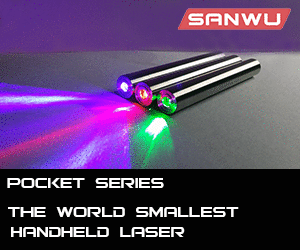Hello, I'm a student and as part of my A levels I'm planning on making a small 10-20 watt co2 laser based on a Liebig condenser, with an arc lengh of about 400mm and a bore of about 15mm. For the high reflector I'm considering using an aluminium hard drive platter if I can't get hold of a proper gold plated one, I am just wondering whether anyone has done anything similar? And will I lose power using a planar mirror?
Just had a few more questions come up and thought to save making a new thread I'd edit this one!
I'm planning on basing my laser on a Liebig condenser, the 400mm one here in particular Condensers, Liebig 400mm effective length means a 400mm water sleeve, so that'll give me a 400mm arc, and about 500-600mm between mirrors. Apparently the internal bore is about 15mm. I intend to use a germanium output coupler to reduce cost, but putting the dimensions of the condenser tube into this equation;
The optimum value for the OC reflectance is given by:
R=1-(Ld)/(500*D)
Where:
R = OC reflectance (as a fraction between 0 for non-reflective to 1 for totally reflective) mirror.
Ld = Length of the discharge (active medium, NOT the distance between mirrors).
D = Diameter of the bore.
Gives an ideal reflectivity of 95%, way above that of germanium's, which I believe is 50%. HOw much of a problem will this be? I want to keep bore size down as my vacuum pump doesn't draw the greatest vacuum, and I want the arc very well cooled, and I also don't want the whole thing to be too long, say 1 meter at the very very maximum. My power supply will be a half bridge of mosfets switching a rectified 2Kw variac into a rectified flyback, so I should be able to get good power and good voltage to strike a reasonably long arc.
Basically I'm wondering if basing the tube on a Liebig condenser is too restricting.... I'd be happy to go for it if I could get a zinc selenide reflector cheaply, but they're difficult to find at a student's budget! Any help is really appreciated.
Just had a few more questions come up and thought to save making a new thread I'd edit this one!
I'm planning on basing my laser on a Liebig condenser, the 400mm one here in particular Condensers, Liebig 400mm effective length means a 400mm water sleeve, so that'll give me a 400mm arc, and about 500-600mm between mirrors. Apparently the internal bore is about 15mm. I intend to use a germanium output coupler to reduce cost, but putting the dimensions of the condenser tube into this equation;
The optimum value for the OC reflectance is given by:
R=1-(Ld)/(500*D)
Where:
R = OC reflectance (as a fraction between 0 for non-reflective to 1 for totally reflective) mirror.
Ld = Length of the discharge (active medium, NOT the distance between mirrors).
D = Diameter of the bore.
Gives an ideal reflectivity of 95%, way above that of germanium's, which I believe is 50%. HOw much of a problem will this be? I want to keep bore size down as my vacuum pump doesn't draw the greatest vacuum, and I want the arc very well cooled, and I also don't want the whole thing to be too long, say 1 meter at the very very maximum. My power supply will be a half bridge of mosfets switching a rectified 2Kw variac into a rectified flyback, so I should be able to get good power and good voltage to strike a reasonably long arc.
Basically I'm wondering if basing the tube on a Liebig condenser is too restricting.... I'd be happy to go for it if I could get a zinc selenide reflector cheaply, but they're difficult to find at a student's budget! Any help is really appreciated.
Last edited:



